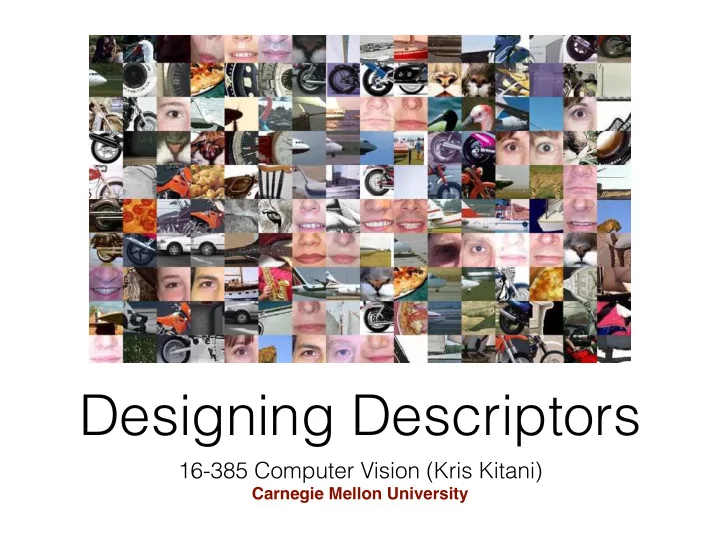

Designing Descriptors 16-385 Computer Vision (Kris Kitani) Carnegie Mellon University
Feature matching is important for tasks like…
Object instance recognition Schmid and Mohr 1997 Sivic and Zisserman, 2003 Rothganger et al. 2003 Lowe 2002
Image mosaicing
If we know where the good features are, how do we match them?
How do we describe an image patch? Patches with similar content should have similar descriptors.
Challenges of designing a feature descriptor
Photometric transformations
Geometric transformations objects will appear at different scales, translation and rotation
Designing a feature descriptor (the search for image invariants)
What is the best descriptor for an image feature?
Image patch Just use the pixel values of the patch 1 2 3 ( ) 1 2 3 4 5 6 7 8 9 4 5 6 vector of intensity values 7 8 9 Perfectly fine if geometry and appearance is unchanged (a.k.a. template matching) What are the problems?
Image patch Just use the pixel values of the patch 1 2 3 ( ) 1 2 3 4 5 6 7 8 9 4 5 6 vector of intensity values 7 8 9 Perfectly fine if geometry and appearance is unchanged (a.k.a. template matching) What are the problems? How can you be less sensitive to absolute intensity values?
Image gradients Use pixel differences 1 2 3 ( ) - + + - - + 4 5 6 vector of x derivatives 7 8 9 Feature is invariant to absolute intensity values What are the problems?
Image gradients Use pixel differences 1 2 3 ( ) - + + - - + 4 5 6 vector of x derivatives 7 8 9 Feature is invariant to absolute intensity values What are the problems? How can you be less sensitive to deformations?
Color histogram Count the colors in the image using a histogram colors Invariant to changes in scale and rotation What are the problems?
Color histogram Count the colors in the image using a histogram colors Invariant to changes in scale and rotation What are the problems?
Color histogram Count the colors in the image using a histogram colors Invariant to changes in scale and rotation What are the problems? How can you be more sensitive to spatial layout?
Spatial histograms Compute histograms over spatial ‘cells’ Retains rough spatial layout Some invariance to deformations What are the problems?
Spatial histograms Compute histograms over spatial ‘cells’ Retains rough spatial layout Some invariance to deformations What are the problems? How can you be completely invariant to rotation?
Orientation normalization Use the dominant image gradient direction to normalize the orientation of the patch ( x, y, s ) θ save the orientation angle along with What are the problems?
Recommend
More recommend